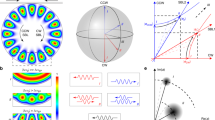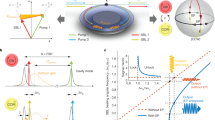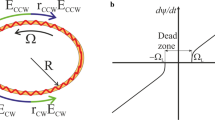Abstract
Gyroscopes are essential to many diverse applications associated with navigation, positioning and inertial sensing1. In general, most optical gyroscopes rely on the Sagnac effect—a relativistically induced phase shift that scales linearly with the rotational velocity2,3. In ring laser gyroscopes (RLGs), this shift manifests as a resonance splitting in the emission spectrum, which can be detected as a beat frequency4. The need for ever more precise RLGs has fuelled research activities aimed at boosting the sensitivity of RLGs beyond the limits dictated by geometrical constraints, including attempts to use either dispersive or nonlinear effects5,6,7,8. Here we establish and experimentally demonstrate a method using non-Hermitian singularities, or exceptional points, to enhance the Sagnac scale factor9,10,11,12,13. By exploiting the increased rotational sensitivity of RLGs in the vicinity of an exceptional point, we enhance the resonance splitting by up to a factor of 20. Our results pave the way towards the next generation of ultrasensitive and compact RLGs and provide a practical approach for the development of other classes of integrated sensor.
This is a preview of subscription content, access via your institution
Access options
Access Nature and 54 other Nature Portfolio journals
Get Nature+, our best-value online-access subscription
$29.99 / 30 days
cancel any time
Subscribe to this journal
Receive 51 print issues and online access
$199.00 per year
only $3.90 per issue
Buy this article
- Purchase on Springer Link
- Instant access to full article PDF
Prices may be subject to local taxes which are calculated during checkout





Similar content being viewed by others
Data availability
All data that support the findings of this study are available within the paper and the Supplementary Information and are available from the corresponding author upon reasonable request.
References
Armenise, M. N., Ciminelli, C., Dell’Olio, F. & Passaro, V. M. Advances in Gyroscope Technologies (Springer, 2010).
Post, E. J. Sagnac effect. Rev. Mod. Phys. 39, 475–493 (1967).
Chow, W. W. et al. The ring laser gyro. Rev. Mod. Phys. 57, 61–104 (1985).
Macek, W. M. & Davis, D. T. M. Jr Rotation rate sensing with traveling-wave ring lasers. Appl. Phys. Lett. 2, 67–68 (1963).
Boyd, R. W. Slow and fast light: fundamentals and applications. J. Mod. Opt. 56, 1908–1915 (2009).
Shahriar, M. S. et al. Ultrahigh enhancement in absolute and relative rotation sensing using fast and slow light. Phys. Rev. A 75, 053807 (2007).
Smith, D. D., Chang, H., Arissian, L. & Diels, J. C. Dispersion-enhanced laser gyroscope. Phys. Rev. A 78, 053824 (2008).
Kaplan, A. E. & Meystre, P. Enhancement of the Sagnac effect due to nonlinearly induced nonreciprocity. Opt. Lett. 6, 590–592 (1981).
Hodaei, H. et al. Enhanced sensitivity at higher-order exceptional points. Nature 548, 187–191 (2017); erratum 551, 658–191 (2017).
Chen, W., Özdemir, Ş. K., Zhao, G., Wiersig, J. & Yang, L. Exceptional points enhance sensing in an optical microcavity. Nature 548, 192–196 (2017).
Ren, J. et al. Ultrasensitive micro-scale parity-time-symmetric ring laser gyroscope. Opt. Lett. 42, 1556–1559 (2017).
Sunada, S. Large Sagnac frequency splitting in a ring resonator operating at an exceptional point. Phys. Rev. A 96, 033842 (2017).
Grant, M. J. & Digonnet, M. J. F. Loss-gain coupled ring resonator gyroscope. In Proc. SPIE Optical, Opto-Atomic, and Entanglement-Enhanced Precision Metrology Vol. 10934 (SPIE, 2019).
Vahala, K. J. Optical microcavities. Nature 424, 839–846 (2003).
Vollmer, F. & Arnold, S. Whispering-gallery-mode biosensing: label-free detection down to single molecules. Nat. Methods 5, 591–596 (2008).
Lu, T. et al. High sensitivity nanoparticle detection using optical microcavities. Proc. Natl Acad. Sci. USA 108, 5976–5979 (2011).
Liang, W. et al. Resonant microphotonic gyroscope. Optica 4, 114–117 (2017).
Makris, K. G., El-Ganainy, R., Christodoulides, D. N. & Musslimani, Z. H. Beam dynamics in PT symmetric optical lattices. Phys. Rev. Lett, 100, 103904 (2008).
Klaiman, S., Gunther, U. & Moiseyev, N. Visualization of branch points in PT-symmetric waveguides. Phys. Rev. Lett, 101, 080402 (2008).
Moiseyev, N. Non-Hermitian Quantum Mechanics (Cambridge Univ. Press, 2011).
Wiersig, J. Enhancing the sensitivity of frequency and energy splitting detection by using exceptional points: application to microcavity sensors for single-particle detection. Phys. Rev. Lett. 112, 203901 (2014).
El-Ganainy, R. et al. Non-Hermitian physics and PT symmetry. Nat. Phys. 14, 11–19 (2018).
Yariv, A. & Yeh, P. Photonics: Optical Electronics in Modern Communications (Oxford Univ. Press, 2006).
Khajavikhan, M., John, K. & Leger, J. R. Experimental measurements of supermodes in superposition architectures for coherent laser beam combining. IEEE J. Quantum Electron. 46, 1221–1231 (2010).
Hu, J., Sun, X., Agarwal, A. & Kimerling, L. C. Design guidelines for optical resonator biochemical sensors. J. Opt. Soc. Am. B 26, 1032–1041 (2009).
LIGO Scientific and Virgo Collaboration. GW170104: observation of a 50-solar-mass binary black hole coalescence at redshift 0.2. Phys. Rev. Lett. 118, 221101 (2017).
Collett, M. J., Loudon, R. & Gardiner, C. W. Quantum theory of optical homodyne and heterodyne detection. J. Mod. Opt. 34, 881–902 (1987).
Mortensen, N. A. et al. Fluctuations and noise-limited sensing near the exceptional point of parity-time-symmetric resonator systems. Optica 5, 1342–1346 (2018).
Zhang, M. et al. Quantum noise theory of exceptional point amplifying sensors. Phys. Rev. Lett. 123, 180501 (2019).
De Carlo, M., De Leonardis, F. & Passaro, V. M. Design rules of a microscale PT-symmetric optical gyroscope using group IV platform. J. Light. Technol. 36, 3261–3268 (2018).
Acknowledgements
We acknowledge support from the US Air Force Office of Scientific Research (FA9550-14-1-0037), Office of Naval Research (N00014-16-1-2640, N00014-18-1-2347, N00014-19-1-2052), National Science Foundation (ECCS1454531, DMR-1420620, ECCS1757025), Army Research Office (W911NF-16-1-0013, W911NF-17-1-0481), US–Israel Binational Science Foundation (BSF) (2016381), DARPA (D18AP00058, HR00111820042, HR00111820038) and the European Commission Project ‘Non-Hermitian Quantum Wave Engineering’ (NHQWAVE, MSCA-RISE 691209). We thank W. Luhs for help in setting up the gyroscope and for performing some of the initial measurements, S. Milady, S. Rotter and K. Vahala for technical discussions, and S. Rotter for supporting this project through funding for A.S.
Author information
Authors and Affiliations
Contributions
All authors contributed equally to this work.
Corresponding author
Ethics declarations
Competing interests
The authors declare no competing interests.
Additional information
Publisher’s note Springer Nature remains neutral with regard to jurisdictional claims in published maps and institutional affiliations.
Peer review information Nature thanks Chia Wei Hsu and the other, anonymous, reviewer(s) for their contribution to the peer review of this work.
Supplementary information
Supplementary Information
This file contains information on analytical calculations of the beat frequency for Hermitian and non-Hermitian ring laser gyroscopes using linear and nonlinear coupled mode theory and Jones calculus
Rights and permissions
About this article
Cite this article
Hokmabadi, M.P., Schumer, A., Christodoulides, D.N. et al. Non-Hermitian ring laser gyroscopes with enhanced Sagnac sensitivity. Nature 576, 70–74 (2019). https://doi.org/10.1038/s41586-019-1780-4
Received:
Accepted:
Published:
Issue Date:
DOI: https://doi.org/10.1038/s41586-019-1780-4
This article is cited by
-
Parity-time symmetry enabled ultra-efficient nonlinear optical signal processing
eLight (2024)
-
A 3D-printed microhemispherical shell resonator with electrostatic tuning for a Coriolis vibratory gyroscope
Microsystems & Nanoengineering (2024)
-
Chiral transmission by an open evolution trajectory in a non-Hermitian system
Light: Science & Applications (2024)
-
An all-optical multidirectional mechano-sensor inspired by biologically mechano-sensitive hair sensilla
Nature Communications (2024)
-
Third-order exceptional line in a nitrogen-vacancy spin system
Nature Nanotechnology (2024)
Comments
By submitting a comment you agree to abide by our Terms and Community Guidelines. If you find something abusive or that does not comply with our terms or guidelines please flag it as inappropriate.



